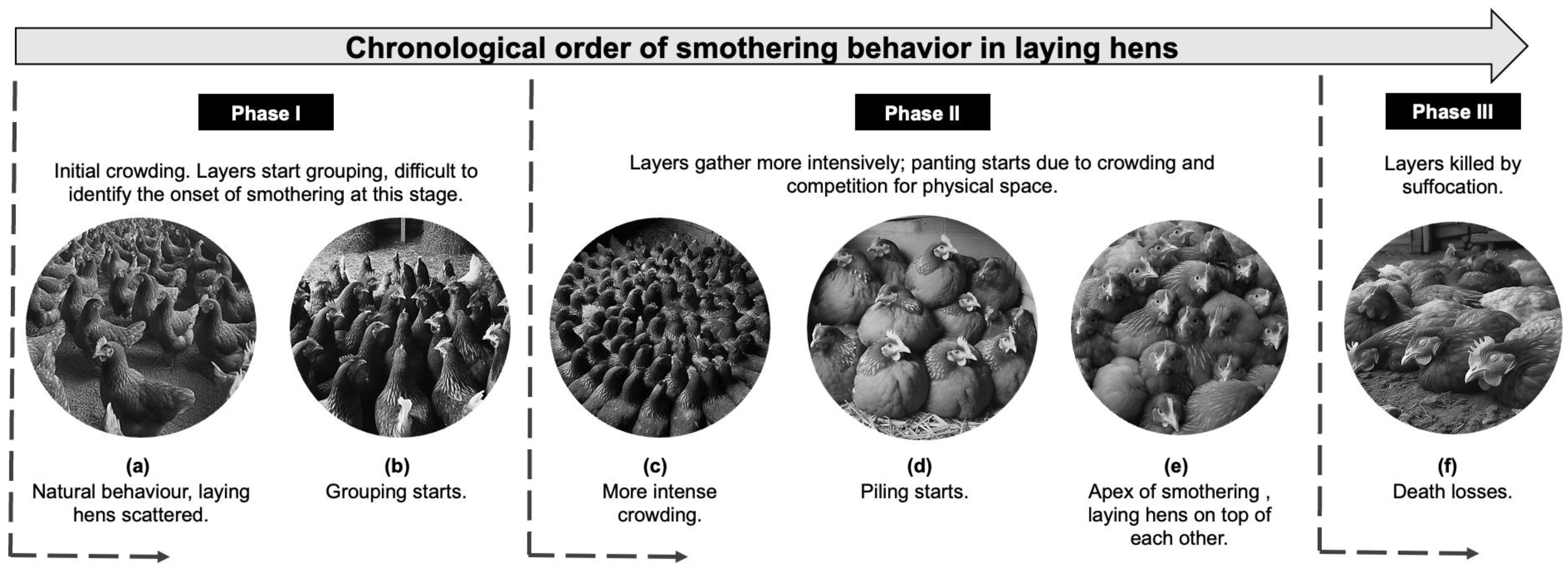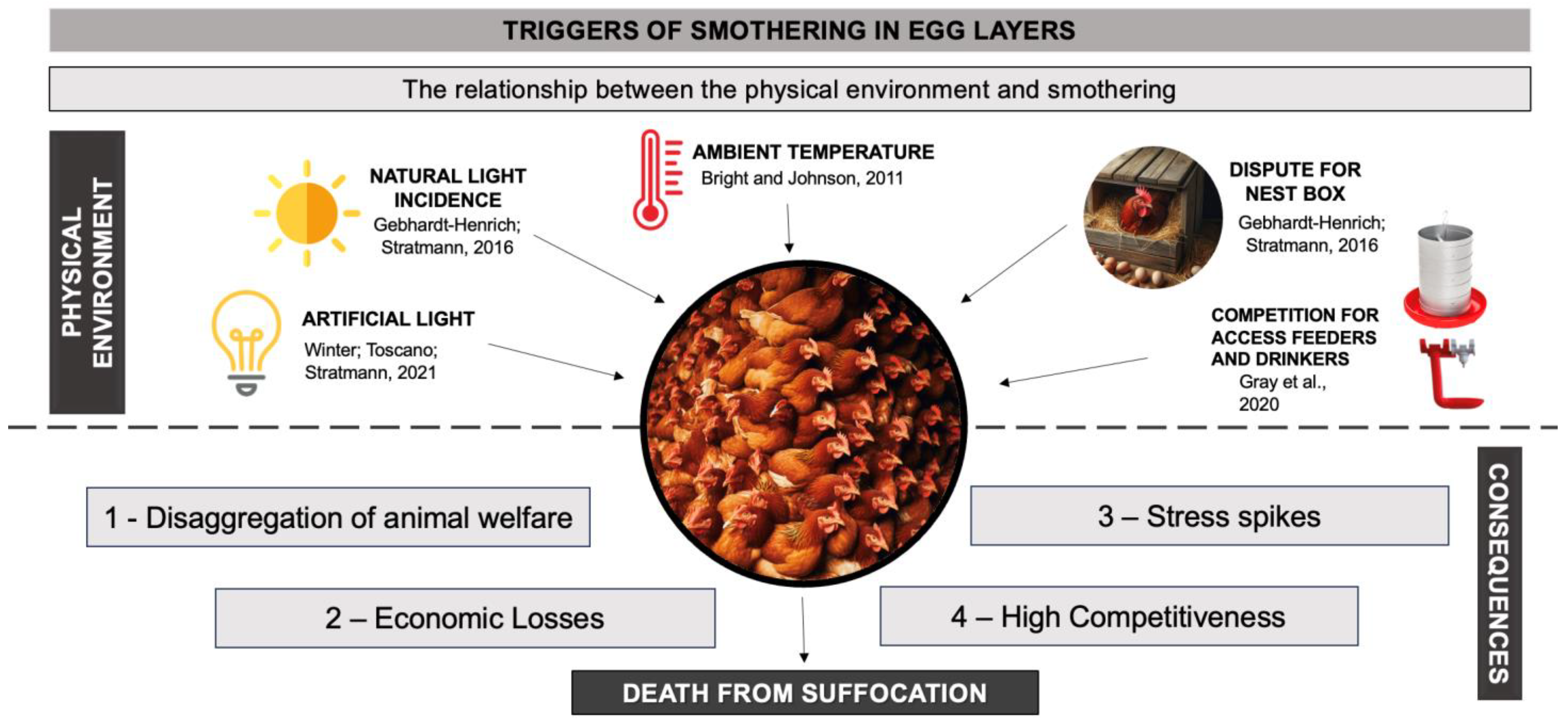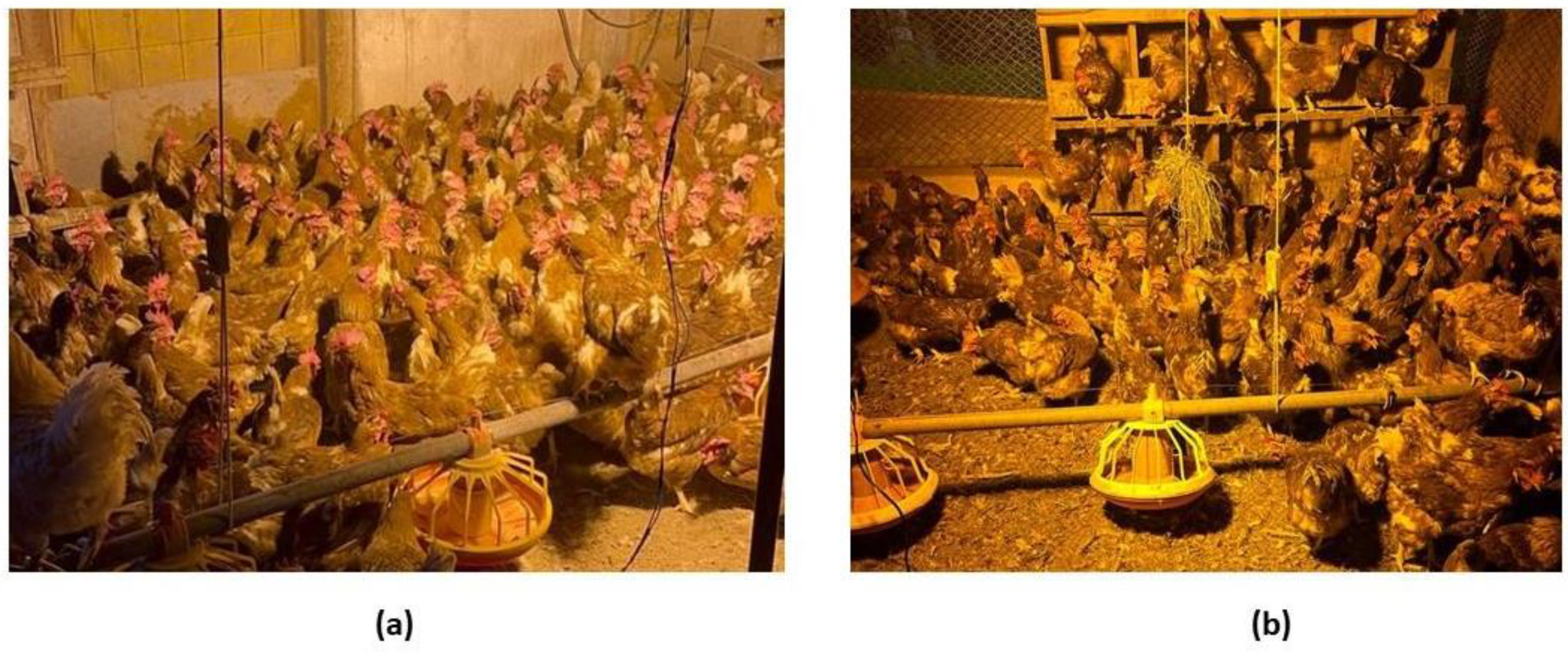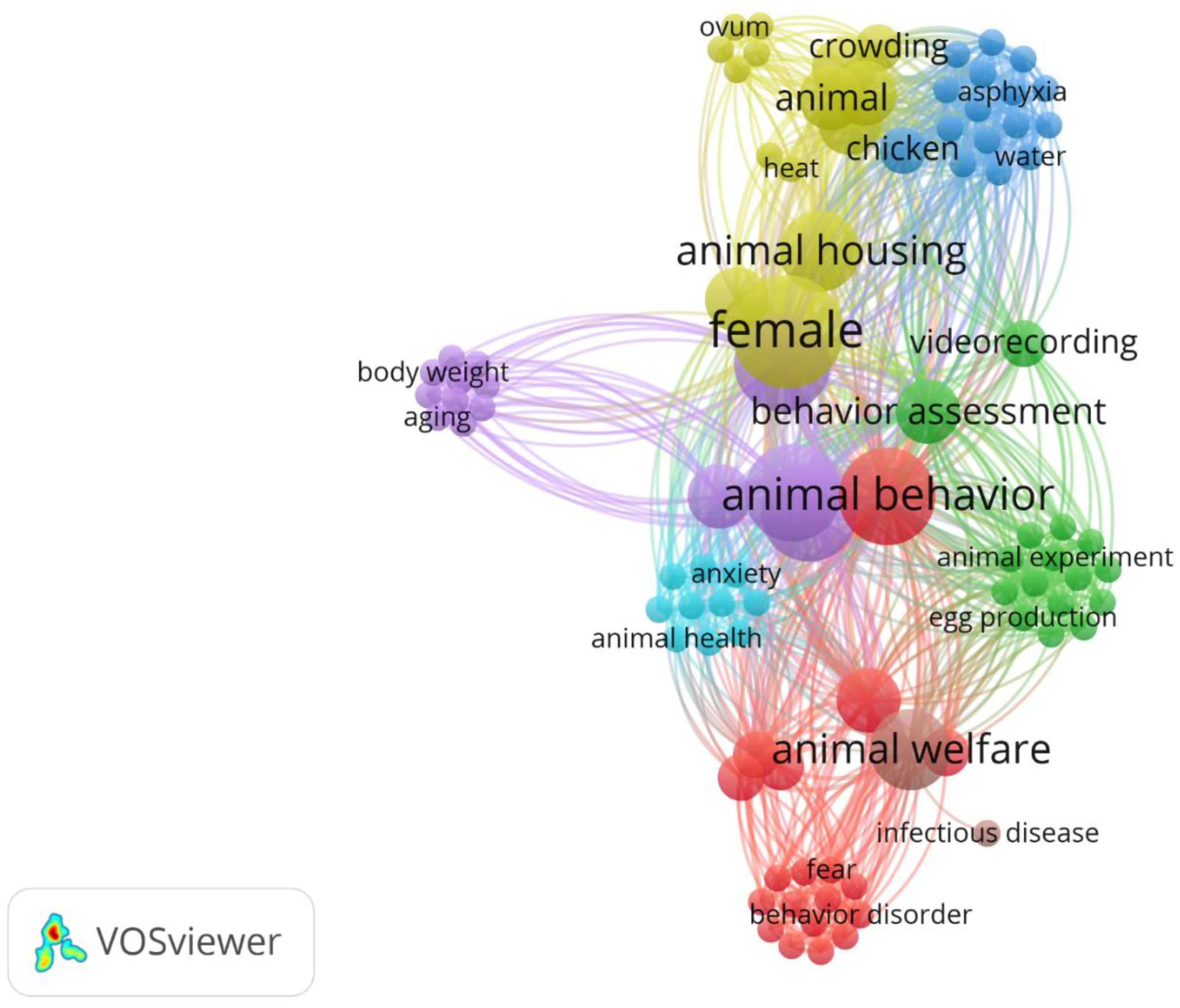Laying Hens: Why Smothering and Not Surviving?—A Literature Review
Abstract
Simple Summary
Abstract
1. Introduction
2. Behavioral Dynamics in Herding and Group Composition Analysis
3. Physiology of Fear and Aversion vs. Abnormal Behaviors
4. What Is Smothering Behavior in Laying Hens?
5. The Relationship of the Physical Environment to Crowding
5.1. Effects of Physical Space
5.2. Effects of Available Resources and Environmental Enrichment
5.3. Effects of the Environment—Temperature and Lighting
5.4. Effects of Human–Animal Management and Interaction
6. Bibliographic Mapping
7. Conclusions
Author Contributions
Funding
Institutional Review Board Statement
Informed Consent Statement
Data Availability Statement
Acknowledgments
Conflicts of Interest
References
- Sousa, G.P.; Pereira, D.F.; Ramos, D.D.; Cataneo, P.F.; Watanabe, K. Percepção dos produtores de ovos de Bastos/SP sobre ambiência, bem-estar animal e legislação na postura comercial. Energ. Agric. 2017, 32, 40–47. [Google Scholar] [CrossRef]
- Compassion in World Farming 1.4 Million Signatures Demanding an End to EU Cages Delivered. Available online: https://www.ciwf.com/media-and-news/news/2020/10/14-million-signatures-demanding-an-end-to-eu-cages-delivered (accessed on 13 February 2024).
- FAO. The State of Food and Agriculture. Available online: https://www.fao.org/3/cc7724en/cc7724en.pdf (accessed on 13 February 2024).
- Dal Bosco, A.; Mattioli, S.; Cartoni Mancinelli, A.; Cotozzolo, E.; Castellini, C. Extensive Rearing Systems in Poultry Production: The Right Chicken for the Right Farming System. A Review of Twenty Years of Scientific Research in Perugia University, Italy. Animals 2021, 11, 1281. [Google Scholar] [CrossRef] [PubMed]
- Ishikawa, A.; Sakaguchi, M.; Nagano, A.J.; Suzuki, S. Genetic Architecture of Innate Fear Behavior in Chickens. Behav. Genet. 2020, 50, 411–422. [Google Scholar] [CrossRef]
- De Haas, E.N.; Kops, M.S.; Bolhuis, J.E.; Groothuis, T.G.G.; Ellen, E.D.; Rodenburg, T.B. The Relation between Fearfulness in Young and Stress-Response in Adult Laying Hens, on Individual and Group Level. Physiol. Behav. 2012, 107, 433–439. [Google Scholar] [CrossRef] [PubMed]
- Bist, R.B.; Subedi, S.; Yang, X.; Chai, L. A Novel YOLOv6 Object Detector for Monitoring Piling Behavior of Cage-Free Laying Hens. AgriEngineering 2023, 5, 905–923. [Google Scholar] [CrossRef]
- Höhne, A.; Petow, S.; Bessei, W.; Schrader, L. Contrafreeloading and Foraging-Related Behavior in Hens Differing in Laying Performance and Phylogenetic Origin. Poult. Sci. 2023, 102, 102489. [Google Scholar] [CrossRef] [PubMed]
- Du, X.; Carpentier, L.; Teng, G.; Liu, M.; Wang, C.; Norton, T. Assessment of Laying Hens’ Thermal Comfort Using Sound Technology. Sensors 2020, 20, 473. [Google Scholar] [CrossRef] [PubMed]
- Papageorgiou, M.; Goliomytis, M.; Tzamaloukas, O.; Miltiadou, D.; Simitzis, P. Positive Welfare Indicators and Their Association with Sustainable Management Systems in Poultry. Sustainability 2023, 15, 10890. [Google Scholar] [CrossRef]
- Mottet, A.; Tempio, G. Global Poultry Production: Current State and Future Outlook and Challenges. Worlds Poult. Sci. J. 2017, 73, 245–256. [Google Scholar] [CrossRef]
- Coton, J.; Guinebretière, M.; Guesdon, V.; Chiron, G.; Mindus, C.; Laravoire, A.; Pauthier, G.; Balaine, L.; Descamps, M.; Bignon, L.; et al. Feather Pecking in Laying Hens Housed in Free-Range or Furnished-Cage Systems on French Farms. Br. Poult. Sci. 2019, 60, 617–627. [Google Scholar] [CrossRef]
- Kozak, A.; Kasperek, K.; Zięba, G.; Rozempolska-Rucińska, I. Variability of Laying Hen Behaviour Depending on the Breed. Asian-Australas. J. Anim. Sci. 2019, 32, 1062–1068. [Google Scholar] [CrossRef] [PubMed]
- Barrett, J.; Rayner, A.C.; Gill, R.; Willings, T.H.; Bright, A. Smothering in UK Free-Range Flocks. Part 1: Incidence, Location, Timing and Management. Vet. Rec. 2014, 175, 19. [Google Scholar] [CrossRef] [PubMed]
- Rayner, A.C.; Gill, R.; Brass, D.; Willings, T.H.; Bright, A. Smothering in UK Free-Range Flocks. Part 2: Investigating Correlations between Disease, Housing and Management Practices. Vet. Rec. 2016, 179, 252. [Google Scholar] [CrossRef] [PubMed]
- Dudek, K.A.; Dion-Albert, L.; Kaufmann, F.N.; Tuck, E.; Lebel, M.; Menard, C. Neurobiology of Resilience in Depression: Immune and Vascular Insights from Human and Animal Studies. Eur. J. Neurosci. 2021, 53, 183–221. [Google Scholar] [CrossRef] [PubMed]
- Gray, H.; Davies, R.; Bright, A.; Rayner, A.; Asher, L. Why Do Hens Pile? Hypothesizing the Causes and Consequences. Front. Vet. Sci. 2020, 7, 616836. [Google Scholar] [CrossRef] [PubMed]
- Winter, J.; Toscano, M.J.; Stratmann, A. Piling Behaviour in Swiss Layer Flocks: Description and Related Factors. Appl. Anim. Behav. Sci. 2021, 236, 105272. [Google Scholar] [CrossRef]
- EU DIRECTIVE 1999/74/EC; Laying Down Minimum Standards for the Protection of Laying Hens. European Union: Brussels, Belgium, 1999.
- Allee, W.C. Animal Aggregations, a Study in General Sociology. The University of Chicago, v. 1, pp. 147–431, 1931. Available online: https://ia801601.us.archive.org/30/items/animalaggregatio00alle/animalaggregatio00alle_bw.pdf (accessed on 13 February 2024).
- Parsons, P.A. Environments and Evolution: Interactions between Stress, Resource Inadequacy and Energetic Efficiency. Biol. Rev. Camb. Philos. Soc. 2005, 80, 589–610. [Google Scholar] [CrossRef] [PubMed]
- Jolles, J.W.; King, A.J.; Killen, S.S. The Role of Individual Heterogeneity in Collective Animal Behaviour. Trends Ecol. Evol. 2020, 35, 278–291. [Google Scholar] [CrossRef] [PubMed]
- Couzin, I.D.; Krause, J. Self-Organization and Collective Behavior in Vertebrates. Adv. Study Behav. 2003, 32, 1–75. [Google Scholar] [CrossRef]
- Grethen, K.J.; Gómez, Y.; Toscano, M.J. Coup in the Coop: Rank Changes in Chicken Dominance Hierarchies over Maturation. Behav. Process. 2023, 210, 104904. [Google Scholar] [CrossRef]
- Li, G.; Li, B.; Shi, Z.; Lu, G.; Chai, L.; Rasheed, K.M.; Regmi, P.; Banakar, A. Interindividual Distances and Orientations of Laying Hens under 8 Stocking Densities Measured by Integrative Deep Learning Techniques. Poult. Sci. 2023, 102, 103076. [Google Scholar] [CrossRef]
- Qanbari, S.; Rubin, C.J.; Maqbool, K.; Weigend, S.; Weigend, A.; Geibel, J.; Kerje, S.; Wurmser, C.; Peterson, A.T.; Lehr Brisbin, I.; et al. Genetics of Adaptation in Modern Chicken. PLoS Genet. 2019, 15, e1007989. [Google Scholar] [CrossRef]
- Kanakachari, M. Indian Red Jungle Fowl Reveals a Genetic Relationship with South East Asian Red Jungle Fowl and Indian Native Chicken Breeds as Evidenced through Whole Mitochondrial Genome Sequences. Front. Genet. 2023, 14, 1083976. [Google Scholar] [CrossRef] [PubMed]
- Siegel, P.B.; Honaker, C.F.; Scanes, C.G. Domestication of Poultry. In Sturkie’s Avian Physiology; Elsevier: Amsterdam, The Netherlands, 2022; pp. 109–120. ISBN 9780128197707. [Google Scholar]
- Liste, G.; Estevez, I. Phenotype Alteration Causes Long-Term Changes to the Social Strategies of Victimised Birds. Sci. Rep. 2023, 13, 2421. [Google Scholar] [CrossRef]
- Carvalho, C.L.; de Oliveira, C.R.; Galli, G.M.; de Oliveira Telesca Camargo, N.; Pereira, M.M.C.; Stefanello, T.B.; Melchior, R.; Andretta, I. Behavior of Domestic Chickens—Insights from a Narrative Review. Rev. Cienc. Agrovet. 2022, 21, 360–369. [Google Scholar] [CrossRef]
- Tokita, C.K.; Tarnita, C.E. Social Influence and Interaction Bias Can Drive Emergent Behavioural Specialization and Modular Social Networks across Systems. J. R. Soc. Interface 2020, 17, 20190564. [Google Scholar] [CrossRef]
- Wang, Y.; Zhang, R.; Wang, L.; Li, J.; Su, Y.; Li, X.; Bao, J. Effect of Social Order, Perch, and Dust-Bath Allocation on Behavior in Laying Hens. Anim. Biosci. 2022, 35, 299–307. [Google Scholar] [CrossRef] [PubMed]
- Michel, V.; Berk, J.; Bozakova, N.; van der Eijk, J.; Estevez, I.; Mircheva, T.; Relic, R.; Rodenburg, T.B.; Sossidou, E.N.; Guinebretière, M. The Relationships between Damaging Behaviours and Health in Laying Hens. Animals 2022, 12, 986. [Google Scholar] [CrossRef]
- Gautron, J.; Réhault-Godbert, S.; Van de Braak, T.G.H.; Dunn, I.C. Review: What Are the Challenges Facing the Table Egg Industry in the next Decades and What Can Be Done to Address Them? Animal 2021, 15, 100282. [Google Scholar] [CrossRef]
- Carvalho, R.R.; Palme, R.; da Silva Vasconcellos, A. An Integrated Analysis of Social Stress in Laying Hens: The Interaction between Physiology, Behaviour, and Hierarchy. Behav. Process. 2018, 149, 43–51. [Google Scholar] [CrossRef]
- Albentosa, M.J.; Cooper, J.J. Testing Resource Value in Group-Housed Animals: An Investigation of Cage Height Preference in Laying Hens. Behav. Process. 2005, 70, 113–121. [Google Scholar] [CrossRef] [PubMed]
- Leone, E.H.; Estevez, I. Use of Space in the Domestic Fowl: Separating the Effects of Enclosure Size, Group Size and Density. Anim. Behav. 2008, 76, 1673–1682. [Google Scholar] [CrossRef]
- Adolphs, R. The Biology of Fear. Curr. Biol. 2013, 23, R79–R93. [Google Scholar] [CrossRef] [PubMed]
- Dickinson, A. Associative Learning and Animal Cognition. Philos. Trans. R. Soc. B Biol. Sci. 2012, 367, 2733–2742. [Google Scholar] [CrossRef] [PubMed]
- Kumar, V.; Bhat, Z.A.; Kumar, D. Animal Models of Anxiety: A Comprehensive Review. J. Pharmacol. Toxicol. Methods 2013, 68, 175–183. [Google Scholar] [CrossRef] [PubMed]
- Cockrem, J.F. Stress, Corticosterone Responses and Avian Personalities. J. Ornithol. 2007, 148, 169–178. [Google Scholar] [CrossRef]
- Taylor, P.S.; Hemsworth, P.H.; Groves, P.J.; Gebhardt-Henrich, S.G.; Rault, J.L. Ranging Behaviour of Commercial Free-Range Broiler Chickens 1: Factors Related to Flock Variability. Animals 2017, 7, 54. [Google Scholar] [CrossRef] [PubMed]
- Rokavec, N.; Zupan Šemrov, M. Psychological and Physiological Stress in Hens With Bone Damage. Front. Vet. Sci. 2020, 7, 589274. [Google Scholar] [CrossRef] [PubMed]
- Hohtola, E. Tonic Immobility and Shivering in Birds: Evolutionary Implications; Pergamon Press and Brain Research Publ.: Oxford, UK, 1981; Volume 27. [Google Scholar]
- Carli, G.; Farabollini, F. The Fear Hypothesis and Tonic Immobility (TI) Modulation: Early Studies in Chickens. In Progress in Brain Research; Elsevier B.V.: Amsterdam, The Netherlands, 2022; Volume 271, pp. 71–99. ISBN 9780323999731. [Google Scholar]
- Marino, L. Thinking Chickens: A Review of Cognition, Emotion, and Behavior in the Domestic Chicken. Anim. Cogn. 2017, 20, 127–147. [Google Scholar] [CrossRef]
- Kleinhappel, T.K.; Pike, T.W.; Burman, O.H.P. Stress-Induced Changes in Group Behaviour. Sci. Rep. 2019, 9, 17200. [Google Scholar] [CrossRef]
- Grumett, D.; Butterworth, A. Electric Shock Control of Farmed Animals: Welfare Review and Ethical Critique. Anim. Welf. 2022, 31, 373–385. [Google Scholar] [CrossRef]
- Barnett, J.L.; Hemsworth, P.H.; Hennessy, D.P.; Mccallum, T.H.; Newman, E.A. The Effects of Modifying the Amount of Human Contact on Behavioural, Physiological and Production Responses of Laying Hens. Appl. Anim. Behav. Sci. 1994, 41, 87–100. [Google Scholar] [CrossRef]
- Winter, J.; Stratmann, A.; Toscano, M.J.; Cardwell, J.M.; Nicol, C.J. Piling Behaviour in British Layer Flocks: Observations and Farmers` Experiences. Appl. Anim. Behav. Sci. 2022, 253, 105686. [Google Scholar] [CrossRef]
- Van De Weerd, H.A.; Keatinge, R.; Roderick, S. A Review of Key Health-Related Welfare Issues in Organic Poultry Production. Worlds Poult. Sci. J. 2009, 65, 649–684. [Google Scholar] [CrossRef]
- Evans, L.; Brooks, G.C.; Anderson, M.G.; Campbell, A.M.; Jacobs, L. Environmental Complexity and Reduced Stocking Density Promote Positive Behavioral Outcomes in Broiler Chickens. Animals 2023, 13, 2074. [Google Scholar] [CrossRef]
- Winter, J.; Toscano, M.J.; Stratmann, A. The Potential of a Light Spot, Heat Area, and Novel Object to Attract Laying Hens and Induce Piling Behaviour. Animal 2022, 16, 100567. [Google Scholar] [CrossRef]
- Sanger, V.L.; Hamdy, A.H. A Strange Fright-Flight Behavior Pattern (Hysteria) in Hens. J. Am. Vet. Med. Assoc. 1962, 140, 455. [Google Scholar]
- Hart, H.; Allee, W.C. The Social Life of Animals. Am. Sociol. Rev. 1939, 4, 587. [Google Scholar] [CrossRef]
- Mills, A.D.; Faure, J.M. Panic and Hysteria in Domestic Fowl: A Review, 1st ed.; Zayan, R., Dantzer, R., Eds.; Kluwer Academic Publishers: Dordrecht, The Netherlands, 1990; Volume 76. [Google Scholar]
- Appleby, M.C.; Mench, J.A.; Hughes, B.O. Hughes Poultry Behaviour and Welfare, 1st ed.; CAB International Press: Wallingford, UK, 2004; Volume 1. [Google Scholar]
- McMullin, P. Differential Diagnosis of Sudden High Mortality in Poultry and Game Birds. Practice 2006, 28, 306–311. [Google Scholar] [CrossRef]
- Bright, A.; Johnson, E.A. Short Communications: Smothering in Commercial Free-Range Laying Hens: A Preliminary Investigation. Vet. Rec. 2011, 168, 203–209. [Google Scholar] [CrossRef]
- Rabiu Mohammed, B.; Ejike Ejiofor, C.; Ejiofor, C. The Prospects and Limitations of Japanese Quail (Coturnix coturnix japonica) Production in Nigeria—A Review. J. Multidiscip. Curr. Res. 2015, 3, 920–926. [Google Scholar]
- Armstrong, D.; Asher, L.; Rayner, A.; Ngidda, H.; Sharma, B.; Gray, H. The Effect of Piling Behavior on the Production and Mortality of Free-Range Laying Hens. Poult. Sci. 2023, 102, 102989. [Google Scholar] [CrossRef] [PubMed]
- Giersberg, M.F.; Kemper, N.; Spindler, B. Pecking and Piling: The Behaviour of Conventional Layer Hybrids and Dual-Purpose Hens in the Nest. Appl. Anim. Behav. Sci. 2019, 214, 50–56. [Google Scholar] [CrossRef]
- Campbell, D.L.M.; Makagon, M.M.; Swanson, J.C.; Siegford, J.M. Litter Use by Laying Hens in a Commercial Aviary: Dust Bathing and Piling. Poult. Sci. 2016, 95, 164–175. [Google Scholar] [CrossRef] [PubMed]
- Collins, L.M.; Asher, L.; Pfeiffer, D.U.; Browne, W.J.; Nicol, C.J. Clustering and Synchrony in Laying Hens: The Effect of Environmental Resources on Social Dynamics. Appl. Anim. Behav. Sci. 2011, 129, 43–53. [Google Scholar] [CrossRef]
- Gebhardt-Henrich, S.G.; Stratmann, A. What Is Causing Smothering in Laying Hens? Vet. Rec. 2016, 179, 250–251. [Google Scholar] [CrossRef] [PubMed]
- Wichman, A.; De Groot, R.; Håstad, O.; Wall, H.; Rubene, D. Influence of Different Light Spectrums on Behaviour and Welfare in Laying Hens. Animals 2021, 11, 924. [Google Scholar] [CrossRef] [PubMed]
- Mench, J.A.; Blatchford, R.A. Determination of Space Use by Laying Hens Using Kinematic Analysis. Poult. Sci. 2014, 93, 794–798. [Google Scholar] [CrossRef]
- Pillan, G.; Xiccato, G.; Ciarelli, C.; Bordignon, F.; Concollato, A.; Pascual, A.; Birolo, M.; Pirrone, F.; Sirri, F.; Averόs, X.; et al. Factors Affecting Space Use by Laying Hens in a Cage-Free Aviary System: Effect of Nest Lighting at Pullet Housing and of Curtain Nest Color during Laying. Poult. Sci. 2023, 102, 102524. [Google Scholar] [CrossRef]
- Carmichael, N.L.; Walker, A.W.; Hughes, B.O. Laying Hens in Large Flocks in a Perchery System: Influence of Stocking Density on Location, Use of Resources and Behaviour. Br. Poult. Sci. 1999, 40, 165–176. [Google Scholar] [CrossRef]
- Lay, D.C.; Fulton, R.M.; Hester, P.Y.; Karcher, D.M.; Kjaer, J.B.; Mench, J.A.; Mullens, B.A.; Newberry, R.C.; Nicol, C.J.; O’Sullivan, N.P.; et al. Hen Welfare in Different Housing Systems. Poult. Sci. 2011, 90, 278–294. [Google Scholar] [CrossRef] [PubMed]
- Appleby, M.C.; Hughes, B.O. Welfare of Laying Hens in Cages and Alternative Systems: Environmental, Physical and Behavioural Aspects. Worlds Poult. Sci. J. 1991, 47, 109–128. [Google Scholar] [CrossRef]
- Leone, E.H.; Christman, M.C.; Douglass, L.; Estevez, I. Separating the Impact of Group Size, Density, and Enclosure Size on Broiler Movement and Space Use at a Decreasing Perimeter to Area Ratio. Behav. Process. 2010, 83, 16–22. [Google Scholar] [CrossRef] [PubMed]
- Weeks, C.A.; Nicol, C.J. Behavioural Needs, Priorities and Preferences of Laying Hens. World’s Poult. Sci. J. 2006, 62, 296–307. [Google Scholar] [CrossRef]
- Riber, A.B. Development with Age of Nest Box Use and Gregarious Nesting in Laying Hens. Appl. Anim. Behav. Sci. 2010, 123, 24–31. [Google Scholar] [CrossRef]
- Altan, O.; Seremet, C.; Hakan Bayraktar, Ö.; Altan, Ö.; Şeremet, Ç.; Bayraktar, H. The Effects of Early Environmental Enrichment on Performance, Fear and Physiological Responses to Acute Stress of Broiler. Arch. Geflügelkunde 2013, 77, 23–28. [Google Scholar]
- Jacobs, L.; Blatchford, R.A.; de Jong, I.C.; Erasmus, M.A.; Levengood, M.; Newberry, R.C.; Regmi, P.; Riber, A.B.; Weimer, S.L. Enhancing Their Quality of Life: Environmental Enrichment for Poultry. Poult. Sci. 2023, 102, 102233. [Google Scholar] [CrossRef]
- Campbell, D.L.M.; De Haas, E.N.; Lee, C. A Review of Environmental Enrichment for Laying Hens during Rearing in Relation to Their Behavioral and Physiological Development. Poult. Sci. 2019, 98, 9–28. [Google Scholar] [CrossRef] [PubMed]
- Cornetto, T.; Estevez, I.; Douglass, L.W. Using Artificial Cover to Reduce Aggression and Disturbances in Domestic Fowl. Appl. Anim. Behav. Sci. 2002, 75, 325–336. [Google Scholar] [CrossRef]
- Dumontier, L.; Janczak, A.M.; Smulders, T.V.; Moe, R.O.; Vas, J.; Nordgreen, J. Early Life Environment and Adult Enrichment: Effects on Fearfulness in Laying Hens. Appl. Anim. Behav. Sci. 2022, 256, 105750. [Google Scholar] [CrossRef]
- Aerni, V.; Brinkhof, M.W.G.; Wechsler, B.; Oester, H.; Fröhlich, E. Productivity and Mortality of Laying Hens in Aviaries: A Systematic Review. World’s Poult. Sci. J. 2005, 61, 130–142. [Google Scholar] [CrossRef]
- Huber-Eicher, B.; Wechsler, B. Feather Pecking in Domestic Chicks: Its Relation to Dustbathing and Foraging. Anim. Behav. 1997, 54, 757–768. [Google Scholar] [CrossRef] [PubMed]
- Xu, D.; Shu, G.; Liu, Y.; Qin, P.; Zheng, Y.; Tian, Y.; Zhao, X.; Du, X. Farm Environmental Enrichments Improve the Welfare of Layer Chicks and Pullets: A Comprehensive Review. Animals 2022, 12, 2610. [Google Scholar] [CrossRef] [PubMed]
- Casey-Trott, T.M.; Korver, D.R.; Guerin, M.T.; Sandilands, V.; Torrey, S.; Widowski, T.M. Opportunities for Exercise during Pullet Rearing, Part II: Long-Term Effects on Bone Characteristics of Adult Laying Hens at the End-of-Lay. Poult. Sci. 2017, 96, 2518–2527. [Google Scholar] [CrossRef] [PubMed]
- Odén, K.; Keeling, L.J.; Algers, B. Behaviour of Laying Hens in Two Types of Aviary Systems on 25 Commercial Farms in Sweden. Br. Poult. Sci. 2002, 43, 169–181. [Google Scholar] [CrossRef] [PubMed]
- Saeed, M.; Abbas, G.; Alagawany, M.; Kamboh, A.A.; Abd El-Hack, M.E.; Khafaga, A.F.; Chao, S. Heat Stress Management in Poultry Farms: A Comprehensive Overview. J. Therm. Biol. 2019, 84, 414–425. [Google Scholar] [CrossRef]
- Pereira, D.F.; Lopes, F.A.A.; Filho, L.R.A.G.; Salgado, D.D.A.; Neto, M.M. Cluster Index for Estimating Thermal Poultry Stress (gallus gallus domesticus). Comput. Electron. Agric. 2020, 177, 105704. [Google Scholar] [CrossRef]
- Herbert, G.T.; Redfearn, W.D.; Brass, E.; Dalton, H.A.; Gill, R.; Brass, D.; Smith, C.; Rayner, A.C.; Asher, L. Extreme Crowding in Laying Hens during a Recurrent Smothering Outbreak. Vet. Rec. 2021, 188, e245. [Google Scholar] [CrossRef]
- Rana, M.S.; Lee, C.; Lea, J.M.; Campbell, D.L.M. Commercial Free-Range Laying Hens’ Preferences for Shelters with Different Sunlight Filtering Percentages. Animals 2022, 12, 344. [Google Scholar] [CrossRef]
- Renema, R.; Wilson, J.L.; Renema, R.A.; Robinson, F.E.; Oosterhoff, H.H.; Feddes, J.J.R.; Wilson, J.L. Effects of Photostimulatory Light Intensity on Ovarian Morphology and Carcass Traits at Sexual Maturity in Modern and Antique Egg-Type Pullets. Poult. Sci. 2001, 80, 47–56. [Google Scholar] [CrossRef]
- Podkowa, P.; Surmacki, A. The Importance of Illumination in Nest Site Choice and Nest Characteristics of Cavity Nesting Birds. Sci. Rep. 2017, 7, 1329. [Google Scholar] [CrossRef] [PubMed]
- Rice, M.; Acharya, R.; Fisher, A.; Taylor, P.; Hemsworth, P. Characterising Piling Behaviour in Australian Free-Range Commercial Laying Hens. In Proceedings of the Conference Publication, ISAE 2020: 54th Congress of the International Society for Applied Ethology, Online Event, 7 July 2020. [Google Scholar]
- Widowski, T.M.; Keeling, L.J.; Duncan, I.J.H. The Preferences of Hens for Compact Fluorescent over Incandescent Lighting. Can. J. Anim. Sci. 1992, 72, 203–211. [Google Scholar] [CrossRef]
- Liu, K.; Xin, H.; Chai, L. Choice Between Fluorescent and Poultry-Specific LED Lights by Pullets and Laying Hens. Trans. ASABE 2017, 60, 2185–2195. [Google Scholar] [CrossRef]
- Gunnarsson, S.; Heikkilä, M.; Hultgren, J.; Valros, A. A Note on Light Preference in Layer Pullets Reared in Incandescent or Natural Light. Appl. Anim. Behav. Sci. 2008, 112, 395–399. [Google Scholar] [CrossRef]
- Mendoza, A.V.; Weimer, S.; Williams, Z. Can UV Light Induce Movement in Cage-Free Laying Hens? J. Appl. Poult. Res. 2023, 32, 100350. [Google Scholar] [CrossRef]
- Prescott, N.B.; Wathes, C.M. Spectral Sensitivity of the Domestic Fowl (Gallus g. domesticus). Br. Poult. Sci. 1999, 40, 332–339. [Google Scholar] [CrossRef] [PubMed]
- Hemsworth, P.H. Human-Animal Interactions in Livestock Production. Appl. Anim. Behav. Sci. 2003, 81, 185–198. [Google Scholar] [CrossRef]
- Edwards, L.E.; Coleman, G.J.; Butler, K.L.; Hemsworth, P.H. The Human-Animal Relationship in Australian Caged Laying Hens. Animals 2019, 9, 211. [Google Scholar] [CrossRef]
- Savory, C.J. Diurnal feeding patterns in domestic fowls: A review. Appl. Anim. Ethol. 1980, 6, 71–82. [Google Scholar] [CrossRef]
- Waldroup, P.W.; Hellwig, H.M. The Potential Value of Morning and Afternoon Feeds for Laying Hens. J. Appl. Poult. Res. 2000, 9, 98–110. [Google Scholar] [CrossRef]
- Balakrishnan, K.N.; Ramiah, S.K.; Zulkifli, I. Heat Shock Protein Response to Stress in Poultry: A Review. Animals 2023, 13, 317. [Google Scholar] [CrossRef] [PubMed]
- Sokołowicz, Z.; Dykiel, M.; Topczewska, J.; Krawczyk, J.; Augustyńska-Prejsnar, A. The Effect of the Type of Non-Caged Housing System, Genotype and Age on the Behaviour of Laying Hens. Animals 2020, 10, 2450. [Google Scholar] [CrossRef] [PubMed]
- McManus, C.; Pimentel, F.; Pimentel, D.; Sejian, V.; Blackburn, H. Bibliographic Mapping of Heat Tolerance in Farm Animals. Livest. Sci. 2023, 269, 105163. [Google Scholar] [CrossRef]
- Köhn, H.; Hubert, L.J. Hierarchical Cluster Analysis. In Wiley StatsRef: Statistics Reference Online; Wiley: Hoboken, NJ, USA, 2015; pp. 1–13. [Google Scholar]







| Authors | Reference | Background | History | Category |
|---|---|---|---|---|
| Hart (1939) | [55] | The physiological effects of disordered clustering are uniformly detrimental. | Clustering is treated as disordered aggregation. | - |
| Sanger VL (1962) | [54] | Unusual escape behavior triggered by fear (hysteria) and the tendency to hide in corners or cluster beneath feeders. | Anomalous behavior | Laying hens |
| Mills (1990) | [56] | Asphyxiation is a significant economic consequence of panic and hysteria in domestic poultry. | Unsatisfactory outcome of hysteria. | Laying hens |
| Michael C. Appleby et al. (2004) | [57] | Clustering is primarily caused by limited space, but it becomes more pronounced in confined environments and small groups. | Clustering is depicted as unsatisfactory, associated with high density. | Broiler chickens |
| McMullin (2006) | [58] | Clustering in a specific area, with those in the center at risk of death due to lack of oxygen and/or excess carbon dioxide. | Triggered by unusual activity. | Laying hens |
| Bright and Johnson (2011) | [59] | Unpredictable behavior is unknown in the free-range egg industry. | Clustering due to an extrinsic factor, likely a fright. | Laying hens |
| Rabiu Mohammed et al. (2015) | [60] | A case of non-infectious mortality. | - | Quails |
| Rayner et al. (2016) | [15] | Three categories. These were (1) panic suffocators (PS), (2) nest box suffocators (NBS), and (3) recurrent suffocators (RS). | - | Laying hens |
| Gray et al. | [17] | Described by severe clustering at points in the poultry house, leading to piles. | Smothering as pyramid formation. | Laying hens |
| Winter et al. (2021) | [18] | Smothering is typically initiated with chickens being influenced by the behavior of their companions and by high concentrations of animals in certain locations. | - | Laying hens |
| Winter et al. (2022) | [50] | Huddling was often observed outside of common interaction hours and appeared to be more likely around noon and when the chickens engaged in various behaviors in the corners of the poultry houses. | - | Laying hens |
| Armstrong et al. (2023) | [61] | In all observations, huddling behavior occurred, regardless of a history of asphyxiation. This suggests that such behavior may be more common than commonly believed. | - | Laying hens |
Disclaimer/Publisher’s Note: The statements, opinions and data contained in all publications are solely those of the individual author(s) and contributor(s) and not of MDPI and/or the editor(s). MDPI and/or the editor(s) disclaim responsibility for any injury to people or property resulting from any ideas, methods, instructions or products referred to in the content. |
© 2024 by the authors. Licensee MDPI, Basel, Switzerland. This article is an open access article distributed under the terms and conditions of the Creative Commons Attribution (CC BY) license (https://creativecommons.org/licenses/by/4.0/).
Share and Cite
Mazocco, C.C.; de Castro Júnior, S.L.; Silveira, R.M.F.; Poletto, R.; da Silva, I.J.O. Laying Hens: Why Smothering and Not Surviving?—A Literature Review. Animals 2024, 14, 1518. https://doi.org/10.3390/ani14111518
Mazocco CC, de Castro Júnior SL, Silveira RMF, Poletto R, da Silva IJO. Laying Hens: Why Smothering and Not Surviving?—A Literature Review. Animals. 2024; 14(11):1518. https://doi.org/10.3390/ani14111518
Chicago/Turabian StyleMazocco, Caroline Citta, Sérgio Luís de Castro Júnior, Robson Mateus Freitas Silveira, Rosangela Poletto, and Iran José Oliveira da Silva. 2024. "Laying Hens: Why Smothering and Not Surviving?—A Literature Review" Animals 14, no. 11: 1518. https://doi.org/10.3390/ani14111518
APA StyleMazocco, C. C., de Castro Júnior, S. L., Silveira, R. M. F., Poletto, R., & da Silva, I. J. O. (2024). Laying Hens: Why Smothering and Not Surviving?—A Literature Review. Animals, 14(11), 1518. https://doi.org/10.3390/ani14111518








